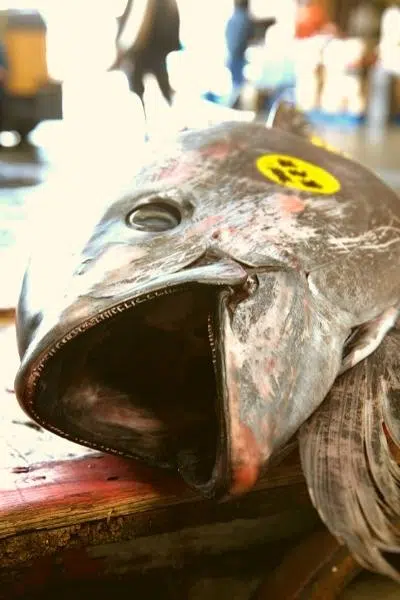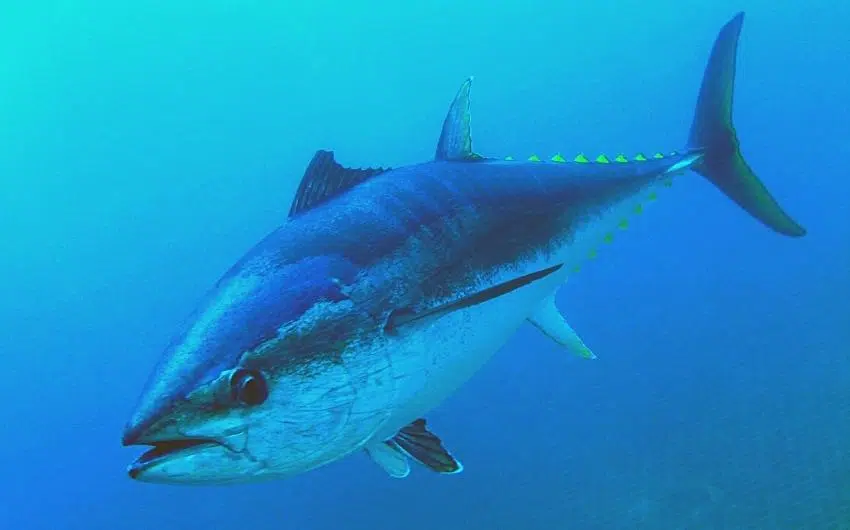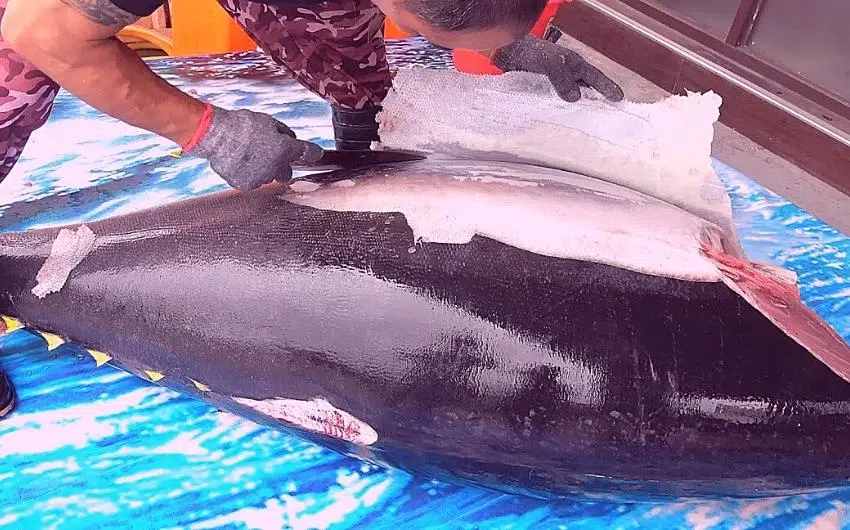Do tuna have scales? The myth that tuna fish doesn’t have scales is a big one. Many people think they’re eating something else when they eat tuna, but this isn’t true! So does tuna fish have scales?
Yes, it absolutely does. It’s not a myth at all, and you can learn the truth about what type of fish has those tiny minor scales in our article today.
We’ve got answers to your questions so you can stop worrying about what type of food you are really eating when you enjoy some delicious canned tuna fish for lunch or dinner.
So, do tuna fish have scales? Let’s find out together if the myth about whether or not tuna species have scales is true or false with my in-depth analysis and research on what makes up a fish, as well as how they are classified based on their physical characteristics.


Quick Jump
ToggleDoes tuna have scales and Fins?
Does a tuna have scales? The quick answer to this query is yes, tuna fish have scales. The beautiful, vibrant colors of the world’s most popular fish are indeed something to marvel at. Tuna fish has rudimentary scales called “scutes.” Yellowfin tuna scales are not like your arm or leg scale type!
So when you’re eating a tuna sandwich or tuna sushi, do not panic just because you see little pieces of tiny scales on your bread. It’s normal to eat fresh tuna with scutes!
Where are tuna scales located?

Tuna fish have scales called Scutes are found on the body of a fish when eating tuna, usually under the dorsal fin but sometimes on the gills.
These tiny scales are small and silvery to almost black in color. They are skinny. Their primary purpose is to protect this kind of fish; tuna fish scales act like armor.
What does the Bible say about eating fish without scales?
You may eat any live creature with anal fins, scales, or both.
Even if it is not appetizing at first glance, do so anyway out of necessity since they provide an essential source of food with few other options available within your environment where you live now.
Bible says, “Of all the creatures living in the water of the seas and the streams, you may eat any fish that have fins and scales.”
The Bible contains many rules for how people should live, but one thing that stands out above all others regarding food is that meaty fish is preferable over slimy ones!
Does yellowfin tuna have scales?
Do tuna have scales? The caudal peduncle is mainly three sets, each with seven to ten finlets.
There’s a band around the body behind the head and corselet that lacks scales; larger ones near its mouth join these into an extended snout-like structure called “diameter.” The eyes aren’t too big, but they do have conical teeth!
How Many Species of Tuna Are There? (Tuna Species)
There are six recognized tuna fish species, though there is debate over whether a seventh should be identified.
The six recognized Tuna Species are:
- Atlantic bluefin tuna (Thunnus thynnus),
- Pacific bluefin tuna (Thunnus Orientalis),
- Southern bluefin tuna (Thunnus maccoyii),
- Bigeye tuna (Thunnus obesus),
- Yellowfin tuna (Thunnus albacares)
- Skipjack tuna (Katsuwonus pelamis).
The possible seventh species is the Atlantic white-sided dolphin (Lagenorhynchus acutus), which is sometimes classified as a subspecies of the common dolphin (Delphinus delphis).
While there are only six or seven species of tuna, there are over 60 different types of stocks of tuna; These stocks can be found in all the world’s oceans and range in size from the albacore tuna, which can grow up to 2.5m long and weigh up to 150kg.
Do all fish have scales?
No, some fish lack scales. The clingfishes (family Gobiesocidae), for example, are scaleless, and it’s not because they’re ugly! They have their own set of defense mechanisms.
There are a few different kinds of other fish species and gobies, including clingfish and sweetlips.
The clingfish is a bottom-dweller with no scales, but it can attach itself to rocks or any surface with its mouth!
What fish has no scales?
Fishes that don’t have prominent scaling, such as the clingfish and catfish families, among others, can be identified by looking at their smooth skin.
They often possess bony plates covered in another layer of tiny teeth-like projections on top of it for protection against potential predators’ attacks.
Some fish lack this protective covering because they live near rocks.
Where there’s little room to grow them; if you wanted an accurate portrayal, then I’d say “fish scales” would suffice but even though these creatures never had any intention whatsoever of making themselves look pretty – why worry? Just let nature take its course!
Is tuna fish kosher food?
Does tuna fish have fins and scales? Pareve fish are those that must have fins and scales to remain kosher.
Some examples of most tuna species include yellowfin tuna, salmon, or tilapia; all shellfish other than crustaceans (including shrimp) and sharks & reptiles fall into this category because they do not have a backbone.
But rather an organized skeleton in their skin like amphibians such as frogs do, which makes them unable for ritual purposes according to the Torah laws about what may be eaten at one meal time during Passover.
What Is Skipjack Tuna?
Skipjack tuna fish is the most popular and widely caught in the world. It’s a small fish, usually weighing 15 and 30 pounds, called “light tuna.”
Skipjack tuna is a schooling fish, which means it lives in large groups of fish. They are found in tropical and sub-tropical waters throughout the world. They are deep-sea fish and can be found at depths of up to 1,000 feet.
Can You Eat Tuna Fish While Pregnant?
Yes, you can eat tuna fish while pregnant, but there are some things to keep in mind. First of all, tuna is a high-mercury fish, so you should limit your consumption to no more than six ounces per week.
Secondly, canned light tuna is a safer choice than fresh or albacore tuna, as it contains less mercury. Finally, make sure to cook the tuna thoroughly to reduce the risk of foodborne illness.
Can I Eat Tuna Fish with Diverticulitis?
Yes, you can eat tuna fish with diverticulitis as long as it is cooked properly.
Raw or undercooked tuna fish can contain harmful bacteria that can cause food poisoning, so it is important to cook it thoroughly. You should also avoid eating other seafood that may contain harmful bacteria, such as oysters and clams.
If you have diverticulitis, it is also important to eat a high-fiber diet and drink plenty of fluids to avoid constipation. constipation can worsen the symptoms of diverticulitis, so it is important to stay hydrated and eat plenty of fiber-rich foods.
Is Canned Tuna Cooked?
Yes, canned tuna is pre-cooked. It’s also been cleaned and deboned before being sealed in a can. That’s why it’s so convenient to have on hand for a quick and easy meal. All you need to do is open the can and enjoy!
However, there are some canned tuna products that are labeled “raw” or “undercooked.” These products should be avoided, as they can contain harmful bacteria. Always make sure to check the label before purchasing canned tuna.
Can You Freeze Canned Tuna?
You can freeze canned tuna. However, some people recommend blanching the tuna first before freezing it. Blanching is the process of boiling food briefly and then cooling it in ice water. It’s used to stop the cooking process and to retain the color, flavor, and texture of food.
Some people also recommend adding a little oil to the canned tuna before freezing it to help prevent freezer burn. However, this is not necessary. If you choose to freeze canned tuna, make sure to do so within two months of opening the can. After that, the quality of the tuna will start to decline.
How Long Is Canned Tuna Good in the Fridge?
Canned tuna is typically good in the fridge for 3-5 days. If it has been opened, however, it should be consumed within 2 days. Once canned tuna has been cooked, it can be stored in the fridge for up to 3 days.
As with all food, it is important to check for signs of spoilage before consuming. Canned tuna that has gone bad will have an off odor, discolored flesh, or a sour taste. If the tuna looks or smells bad, it should be thrown out.
What Is the Difference Between Canned Tuna and Fresh Tuna?
Canned tuna is a processed food product that has been cooked, canned, and typically shelf-stable. Fresh tuna, on the other hand, is a raw, fresh fish that must be cooked before eating.
Canned tuna is a convenient option for quick and easy meals. It can be eaten straight from the can or used in recipes. Fresh tuna, on the other hand, is best when cooked properly.
Commonly Asked Questions about Tuna Scales and skin in fishes (FAQ)
Is tuna unclean in the Bible? (clean fish or unclean!)
The Bible is filled with descriptions of foods that are not allowed for Jews, but it’s also very clear which creatures fall into this category. For example, certain types of tuna fish – bluefin tuna and yellowfin tuna cannot be eaten because they lack scales.
Do mackerel have scales?
The mackerel’s tuna scales are so small that it feels velvety to the touch. The larger pectoral fins and shoulders on this fish can be seen with ease, but those found just below its belly remain hidden until they’re in close range for inspection. It may seem hard at first glance due to their minuscule size; however, these tiny creatures have some extremely delicate-looking coverings!
Does canned tuna have scales?
Yeah, I’ll admit that canned fish have scales. They’re pretty covered in scales all over the fish’s entire body except for where you can see some small ones up close and which area gets larger as well.
Does a Bluefin tuna have scales?
Bluefin tuna fish is considered a Kosher fish with very few scales. The scales of a Bluefin tuna are very small and difficult to see.
Does salmon have scales?
Salmon have a layer of scales covering their smooth skin. Scales are small, hard plates covering the body for protection from predators and bruising; they also overlap to form flexible armor plating! Fish never lose these protective layers as long as they live, which is why salmon can be identified by its unique coloring.
Is tuna fish halal in Islam?
All fish from the ocean or sea, whether yellowfin tuna, albacore tuna, ahi tuna, salmon, or whale, are considered halal.
Do sardines have scales and fins?
A sardine is a small, silvery fish with no scales on its head and only one short fin. It has an elongated shape that can be up to five inches long when fully grown in adulthood – much smaller than most other types of seafood!
Does albacore tuna have scales?
The scales of albacore tuna are so small you can’t even see them. Because they are so tiny, the naked eye of albacore tuna may appear to be the only scales and fins on their body.
Does skipjack tuna have scales?
Skipjack tuna has no scales other than on the corselet (a band of large, thick skin) and faint lateral line running lengthwise down each side.
Does codfish have scales?
Codfish may be identified based on their small scales and large gill openings. People often confuse several types of cod with one another, but for this post, we will only discuss the Atlantic Cod since that has been most commonly used in manufacturing.
Does tuna have fins and scales?
Tuna have fins on their bodies. Most of the time you see tuna flesh, it is taken from the back fin area since it is meaty and has a lot of flesh.
Do bass fish have scales?
scales and fins are a major component of the fish’s integumentary system. The bass fish’s outer body near the head is covered with scales, which provide protection and assist in regulating water flow through openings called pores on its surface to help control temperature levels inside it.
Do catfish have scales?
The skin has various ways of protecting these fish; it can serve as effective cutaneous respiration by allowing them to breathe through their pores or, if covered by a mucus layer, utilize this method instead.
Which tuna has the highest mercury levels?
Tuna is a healthy and affordable protein source for your diet. Albacore tuna fish have higher levels of mercury content that may cause health problems for adults. Also, white canned light tuna varieties can still be eaten safely if you’re looking to minimize exposure time in the presence of toxic metals such as this one!
Conclusion
So, does tuna fish have scales and fins? We all know that yellowfin tuna fish have scales and fins. But, did you also know it is the only kosher fish? The Bible says we should not eat any seafood without scales or fins – which means that other common types of fish such as salmon, tilapia, and catfish are strictly forbidden. If you’re looking for a list of kosher-friendly foods to add to your diet while observing Passover this year, keep in mind what type of animal meat they come from (or don’t).
You will also love:

